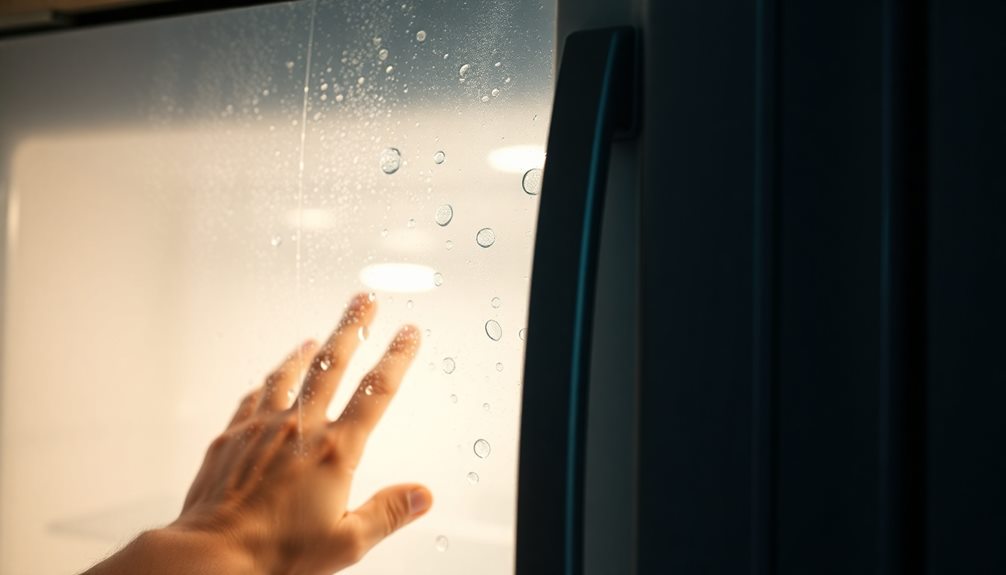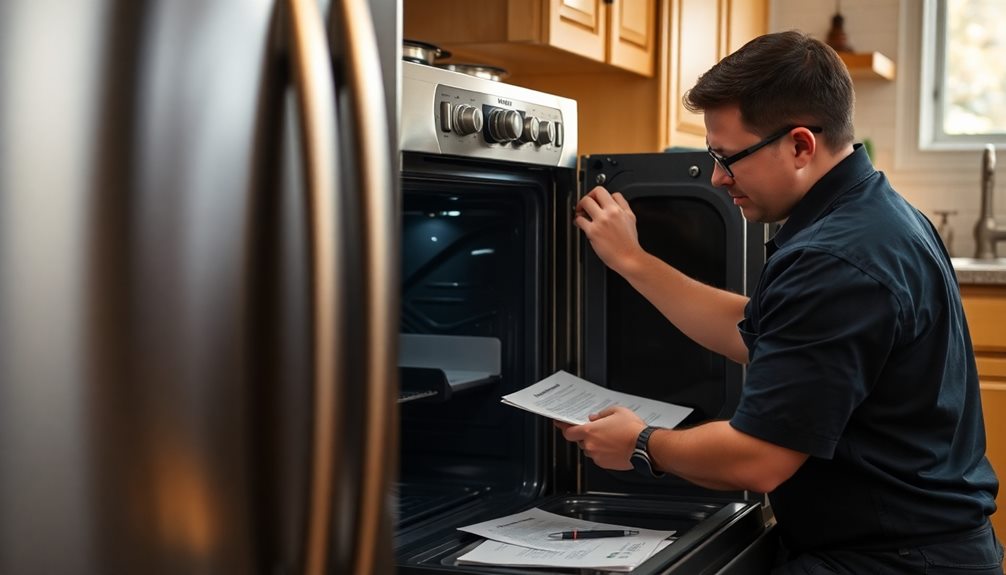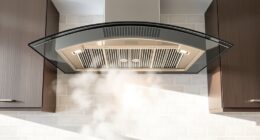If your refrigerator's hot to the touch, it's time to check a few things. Warm surfaces can indicate it's functioning properly, but overheating might signal bigger issues. Inspect for blocked vents, clean the condenser coils, and verify door seals are intact. Poor airflow and damaged seals can lead to energy waste and temperature fluctuations. If you hear unusual sounds or notice persistent heat, consider seeking professional help. Regular maintenance can keep everything running smoothly. There's more you can do to troubleshoot these concerns and maintain your fridge's efficiency.
Key Takeaways
- A warm exterior is normal during operation, but persistent heat may indicate airflow or cooling issues.
- Ensure proper ventilation by maintaining at least 50 mm clearance around the refrigerator.
- Regularly inspect door seals for damage, as leaks can cause temperature fluctuations and increased energy use.
- Clean condenser coils every 6 months to improve efficiency and mitigate overheating concerns.
- Seek professional help if overheating persists, unusual sounds occur, or oily spots are present around the unit.
Normal Refrigerator Temperature
When it comes to your refrigerator, knowing the normal internal temperature is vital for keeping your food safe and fresh. A well-functioning refrigerator typically maintains an internal temperature between 35°F and 38°F. This range is essential for food safety, guaranteeing that perishable items remain uncontaminated.
During the refrigeration process, it's normal for the exterior surfaces, especially near the compressor and condenser coils, to feel warm. This warmth indicates proper functioning as heat dissipates during operation. However, you should regularly check the temperature to ascertain peak performance.
If you notice that your refrigerator is consistently running outside the normal temperature range, it may be time for some troubleshooting. An excessively hot appliance could signal an underlying issue that needs addressing. In such cases, don't hesitate to seek professional assistance to diagnose and resolve the problem.
Keeping an eye on your refrigerator's temperature not only helps maintain food safety but also extends the life of your appliance. By staying proactive, you can avoid potential issues and guarantee that your refrigerator operates efficiently and effectively.
Installation Guidelines
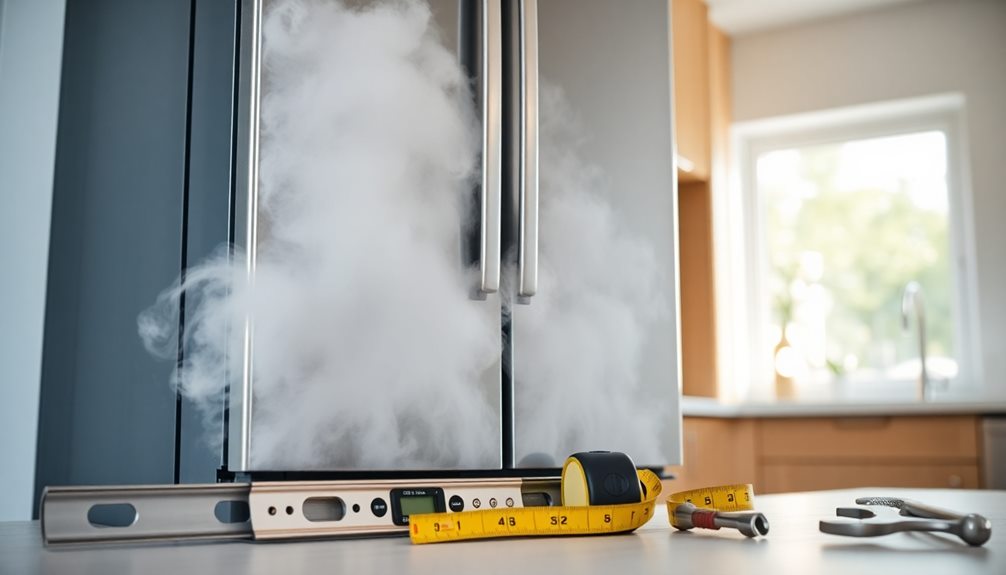
Your refrigerator's installation plays an essential role in its performance and efficiency. To guarantee it operates at peak cooling efficiency and longevity, follow these installation guidelines:
- Allow adequate airflow: Guarantee a minimum spacing of 50 mm around the sides and back of the refrigerator to promote proper ventilation.
- Top clearance matters: Maintain at least 25 mm of space at the top of the unit to prevent overheating and support effective heat dissipation.
- Watch out for heat sources: Avoid placing the refrigerator near ovens or in direct sunlight, as this can raise surface temperatures and negatively affect performance.
- Regular checks: Periodically inspect your installation environment to guarantee that airflow isn't obstructed, which can lead to increased temperature and overheating issues.
Troubleshooting Excess Heat

If your refrigerator feels excessively hot, start by identifying nearby heat sources that could be affecting its performance.
Next, inspect the ventilation spaces to guarantee there's enough airflow around the appliance.
Identify Heat Sources
Identifying heat sources is essential for troubleshooting excessive heat in your refrigerator. If you notice that your appliance feels hot to the touch, it's vital to pinpoint the cause. Here are some common culprits that could be contributing to the issue:
- Insufficient ventilation around the refrigerator
- Blocked condenser coils that need cleaning
- Proximity to heat sources, like ovens or direct sunlight
- Malfunctioning fan or compressor
When it comes to your refrigerator, some warmth during operation is normal due to heat dissipation. However, if the sides are constantly hot, you might face deeper issues, such as a faulty compressor or a malfunctioning fan.
It's important to guarantee proper airflow around your refrigerator by keeping vents clear and maintaining a suitable distance from other heat sources.
If you've tried these steps and the problem persists, don't hesitate to seek a professional inspection.
Regular maintenance, like cleaning the condenser coils, can enhance efficiency and prevent excessive heat buildup. Stay proactive, and you'll help your refrigerator run smoothly for years to come!
Inspect Ventilation Spaces
To guarantee your refrigerator operates efficiently, it's imperative to inspect the ventilation spaces around it. Ascertain there's a minimum of 50 mm of clearance on the sides and back, and at least 25 mm at the top. Proper ventilation is essential to prevent overheating and maintain peak performance.
If airflow is restricted, your refrigerator may work harder than necessary, leading to increased surface temperatures and potentially shortening its lifespan.
Be mindful of heat sources during installation; avoid placing your refrigerator near ovens or in direct sunlight, as this can further restrict airflow. Regularly check for obstructions around the refrigerator that may impede airflow, like boxes or debris. Even small items can block vents and contribute to overheating issues.
Incorporating these maintenance tips not only helps your refrigerator run more efficiently but also enhances its energy efficiency. Restricted airflow can increase energy consumption, so keeping those ventilation spaces clear is imperative.
Monitor Appliance Performance
After guaranteeing proper ventilation, it's time to monitor your refrigerator's performance for any signs of excess heat. If the sides of your refrigerator feel hot to the touch, it could indicate a malfunction.
It's important to remember that preventive maintenance can greatly extend the lifespan of your appliance. Here's what you should keep an eye on:
- Air circulation: Guarantee there's enough space around the refrigerator for air to circulate.
- Installation: Check that the refrigerator is level and installed correctly; improper installation can lead to overheating.
- Nearby heat sources: Be mindful of ovens or direct sunlight that might influence your refrigerator's temperature.
- Maintenance checks: Regularly clean the condenser coils and inspect door seals to prevent heat buildup.
Routine monitoring is essential for ideal appliance performance. If you notice persistent heat, it's best to contact support at 1300 362 603 for assistance.
Addressing these factors will help guarantee your refrigerator operates efficiently and reduces the risk of overheating. Keeping up with these checks won't only prolong the life of your appliance but also maintain its efficiency in keeping your food fresh.
Maintenance Recommendations
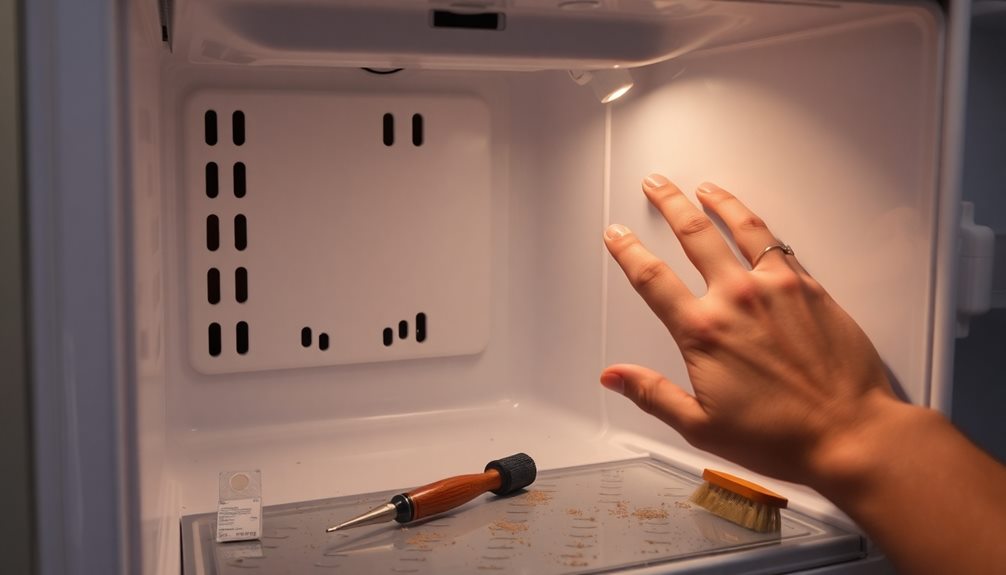
Maintaining your refrigerator is vital to preventing overheating and guaranteeing it operates efficiently. Regular maintenance recommendations can greatly enhance the lifespan of your appliance and improve its performance.
| Task | Frequency | Importance |
|---|---|---|
| Clean condenser coils | Every 6 months | Prevents dust buildup, improving airflow and efficiency. |
| Inspect door seals | Every 3 months | Makes sure cold air stays in, reducing strain on the compressor. |
| Check temperature settings | Monthly | Keeps temperature between 35°F and 38°F for ideal performance and energy consumption. |
| Verify proper ventilation | Ongoing | Maintain at least 50 mm space around sides and back, and 25 mm at the top for proper airflow. |
Additionally, scheduling professional maintenance annually is imperative. This will allow a technician to check your cooling system for potential issues and verify all components function correctly. By following these maintenance tips, you can avoid overheating and keep your refrigerator running smoothly for years to come.
Common User Experiences

You might've noticed that your refrigerator often feels hot to the touch, especially around the freezer door and compressor.
Many users report issues like damaged seals that lead to temperature fluctuations and increased surface heat.
Understanding these common experiences can help you identify if your fridge needs some attention or maintenance.
Frequent Overheating Reports
Many users have shared alarming experiences with their refrigerators overheating, particularly around the mullion area where the refrigerator and freezer doors meet. This issue often manifests as a surface that feels hot to touch, raising concerns about safety and functionality.
Additionally, maintaining proper airflow around the unit can be vital, as blocked vents may exacerbate the overheating issue. Keeping the refrigerator clean and ensuring the seals are intact are essential steps in preventing these problems, as air purifier maintenance dos and don'ts highlight the importance of regular upkeep.
Here are some common observations from user feedback:
- Excessive heat around the door seals, indicating potential insulation problems.
- Increased instances of cooling failures, especially in older refrigerator models.
- Reports of cold air escaping, contributing to the overheating.
- Temporary fixes, like turning off the unit, only provide short-term relief.
These overheating reports frequently highlight the importance of proper door seals and effective insulation. When seals are damaged, cold air can escape, forcing your refrigerator to work harder and leading to overheating.
While many users seek quick solutions, it's vital to recognize that these temporary fixes won't address the root cause of the problem. If you're experiencing similar issues, consider consulting a professional to assess your refrigerator's performance and prevent further complications.
Your appliance's longevity and efficiency depend on addressing these overheating concerns promptly.
Seal Damage Issues
Experiencing overheating issues often leads users to discover another common culprit: seal damage. Worn seals on your refrigerator's door gaskets can allow cold air to escape, causing excessive heat and forcing the compressor to work harder. This not only impacts cooling performance but also increases energy consumption, leading to higher utility bills.
To help you identify seal damage, consider the following signs:
| Signs of Seal Damage | Impact on Refrigerator |
|---|---|
| Cold air escaping | Increased energy consumption and spoilage |
| Visible wear or tears in seals | Compromised appliance efficiency |
| Frost buildup inside the fridge | Overheating and potential damage to components |
Addressing seal damage promptly can prevent further complications, such as excessive heat and frost buildup. Regularly inspecting your door gaskets helps maintain temperature stability and extends the lifespan of your refrigerator. If you notice issues, replacing damaged seals can restore proper cooling performance and improve your appliance's efficiency. Don't wait—act now to keep your refrigerator running smoothly!
Temperature Fluctuation Experiences
Temperature fluctuations in refrigerators can be a frustrating experience for homeowners, often leading to worries about food safety and spoilage. You might notice the interior temperature rising beyond the recommended 35°F to 38°F, which can put your food at risk.
Often, these fluctuations stem from issues like compressor operation or poor air circulation. Additionally, integrating smart home technology can help monitor your refrigerator's performance and alert you to any irregularities, enhancing your overall appliance management through smart home device integration.
Here are some common experiences you might relate to:
- Warm surfaces on the refrigerator's exterior, especially on older models.
- Excessive heat caused by obstructed airflow from overloaded shelves.
- Difficulty maintaining consistent cooling performance due to blocked vents.
- Improved stability in internal temperatures after cleaning condenser coils.
If your refrigerator feels hot to the touch, it may indicate overheating. To combat this, make certain proper ventilation around your fridge and avoid overloading it.
Cleaning the condenser coils regularly can also enhance cooling performance. Be mindful of air circulation; obstructed airflow can lead to significant temperature fluctuations, risking food spoilage.
Addressing these issues promptly can help maintain a safe and effective refrigerator environment, making sure your food stays fresh and safe.
When to Seek Help

Sometimes, a refrigerator that's hot to the touch signals a problem you can't fix on your own. If you've tried basic troubleshooting and the overheating persists, it may indicate a serious issue within the cooling system that requires professional assistance.
Listen for unusual sounds like loud buzzing or clicking. These noises often mean components are malfunctioning, and a qualified technician needs to diagnose and repair them. Frequent breakdowns or erratic behavior from the compressor are also signs that you should seek help.
Don't ignore these red flags; addressing them sooner can prevent further damage.
If you notice oily spots around the unit, it could mean a refrigerant leak. This is a safety concern that warrants immediate professional attention. Refrigerant leaks not only affect your refrigerator's efficiency but can also pose health risks.
When basic maintenance steps don't resolve the overheating, it's essential to call in a technician. They've the expertise to tackle complex issues related to the compressor and overall refrigeration performance.
Frequently Asked Questions
What Does It Mean When Your Refrigerator Is Hot to the Touch?
When your refrigerator's hot to the touch, it might be normal due to heat dissipation. However, if it's excessively hot, check for blocked coils or poor ventilation; you may need professional help if problems persist.
Is It Normal for the Body of a Fridge to Be Hot?
Did you know that over 70% of fridges feel warm on the sides? It's normal for your fridge's body to be hot due to heat dissipation. Just guarantee there's enough space around it for airflow.
Why Are My Fridge Door Seals Hot to the Touch?
Your fridge door seals might feel hot due to insufficient airflow, damaged seals, or excessive dust on the condenser coils. Make sure to clean coils regularly and check seals to maintain ideal cooling performance.
Should a Refrigerator Compressor Be Hot to the Touch?
Your refrigerator's compressor might feel like a warm hug during its work. It's normal for it to be hot, but if it burns, check for airflow issues or call a pro to help you out.
Conclusion
So, is your refrigerator really supposed to be hot to the touch? While it's normal for some heat to escape, excessive warmth can signal trouble. By following proper installation guidelines and regular maintenance, you can keep your fridge running efficiently. If you've tried troubleshooting and still feel the heat, don't hesitate to seek professional help. After all, a cool fridge guarantees your food stays fresh and safe—something you definitely don't want to take for granted!
